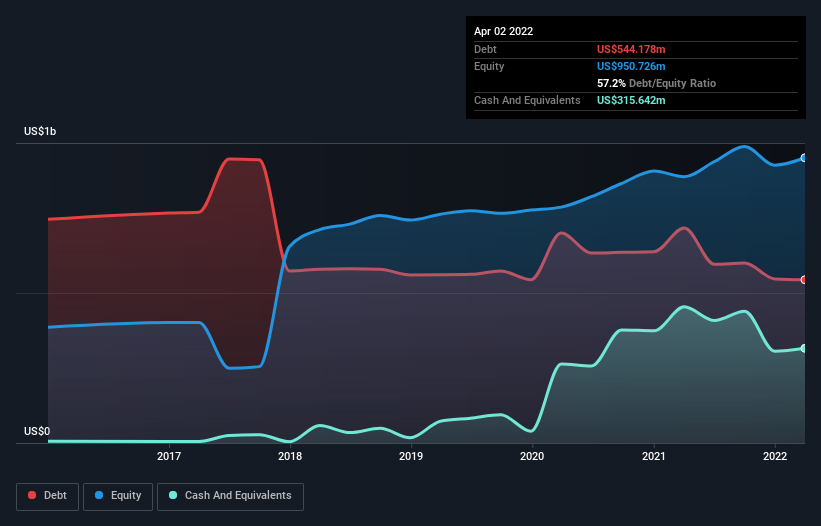- United States
- /
- Specialty Stores
- /
- NasdaqGS:EYE
Is National Vision Holdings (NASDAQ:EYE) A Risky Investment?

Some say volatility, rather than debt, is the best way to think about risk as an investor, but Warren Buffett famously said that 'Volatility is far from synonymous with risk.' It's only natural to consider a company's balance sheet when you examine how risky it is, since debt is often involved when a business collapses. As with many other companies National Vision Holdings, Inc. (NASDAQ:EYE) makes use of debt. But the real question is whether this debt is making the company risky.
When Is Debt A Problem?
Debt is a tool to help businesses grow, but if a business is incapable of paying off its lenders, then it exists at their mercy. In the worst case scenario, a company can go bankrupt if it cannot pay its creditors. While that is not too common, we often do see indebted companies permanently diluting shareholders because lenders force them to raise capital at a distressed price. Of course, plenty of companies use debt to fund growth, without any negative consequences. When we examine debt levels, we first consider both cash and debt levels, together.
View our latest analysis for National Vision Holdings
How Much Debt Does National Vision Holdings Carry?
You can click the graphic below for the historical numbers, but it shows that National Vision Holdings had US$544.2m of debt in April 2022, down from US$717.1m, one year before. However, it also had US$315.6m in cash, and so its net debt is US$228.5m.

How Healthy Is National Vision Holdings' Balance Sheet?
We can see from the most recent balance sheet that National Vision Holdings had liabilities of US$345.4m falling due within a year, and liabilities of US$1.03b due beyond that. Offsetting this, it had US$315.6m in cash and US$62.2m in receivables that were due within 12 months. So its liabilities total US$996.9m more than the combination of its cash and short-term receivables.
National Vision Holdings has a market capitalization of US$2.43b, so it could very likely raise cash to ameliorate its balance sheet, if the need arose. But it's clear that we should definitely closely examine whether it can manage its debt without dilution.
We measure a company's debt load relative to its earnings power by looking at its net debt divided by its earnings before interest, tax, depreciation, and amortization (EBITDA) and by calculating how easily its earnings before interest and tax (EBIT) cover its interest expense (interest cover). Thus we consider debt relative to earnings both with and without depreciation and amortization expenses.
National Vision Holdings has a low net debt to EBITDA ratio of only 0.91. And its EBIT easily covers its interest expense, being 10.1 times the size. So we're pretty relaxed about its super-conservative use of debt. And we also note warmly that National Vision Holdings grew its EBIT by 13% last year, making its debt load easier to handle. When analysing debt levels, the balance sheet is the obvious place to start. But it is future earnings, more than anything, that will determine National Vision Holdings's ability to maintain a healthy balance sheet going forward. So if you're focused on the future you can check out this free report showing analyst profit forecasts.
Finally, a business needs free cash flow to pay off debt; accounting profits just don't cut it. So we always check how much of that EBIT is translated into free cash flow. During the last three years, National Vision Holdings generated free cash flow amounting to a very robust 94% of its EBIT, more than we'd expect. That puts it in a very strong position to pay down debt.
Our View
Happily, National Vision Holdings's impressive conversion of EBIT to free cash flow implies it has the upper hand on its debt. And the good news does not stop there, as its interest cover also supports that impression! Taking all this data into account, it seems to us that National Vision Holdings takes a pretty sensible approach to debt. While that brings some risk, it can also enhance returns for shareholders. The balance sheet is clearly the area to focus on when you are analysing debt. But ultimately, every company can contain risks that exist outside of the balance sheet. To that end, you should be aware of the 1 warning sign we've spotted with National Vision Holdings .
If, after all that, you're more interested in a fast growing company with a rock-solid balance sheet, then check out our list of net cash growth stocks without delay.
Valuation is complex, but we're here to simplify it.
Discover if National Vision Holdings might be undervalued or overvalued with our detailed analysis, featuring fair value estimates, potential risks, dividends, insider trades, and its financial condition.
Access Free AnalysisHave feedback on this article? Concerned about the content? Get in touch with us directly. Alternatively, email editorial-team (at) simplywallst.com.
This article by Simply Wall St is general in nature. We provide commentary based on historical data and analyst forecasts only using an unbiased methodology and our articles are not intended to be financial advice. It does not constitute a recommendation to buy or sell any stock, and does not take account of your objectives, or your financial situation. We aim to bring you long-term focused analysis driven by fundamental data. Note that our analysis may not factor in the latest price-sensitive company announcements or qualitative material. Simply Wall St has no position in any stocks mentioned.
About NasdaqGS:EYE
National Vision Holdings
Through its subsidiaries, operates as an optical retailer in the United States.
Moderate growth potential with mediocre balance sheet.
Similar Companies
Market Insights
Community Narratives




